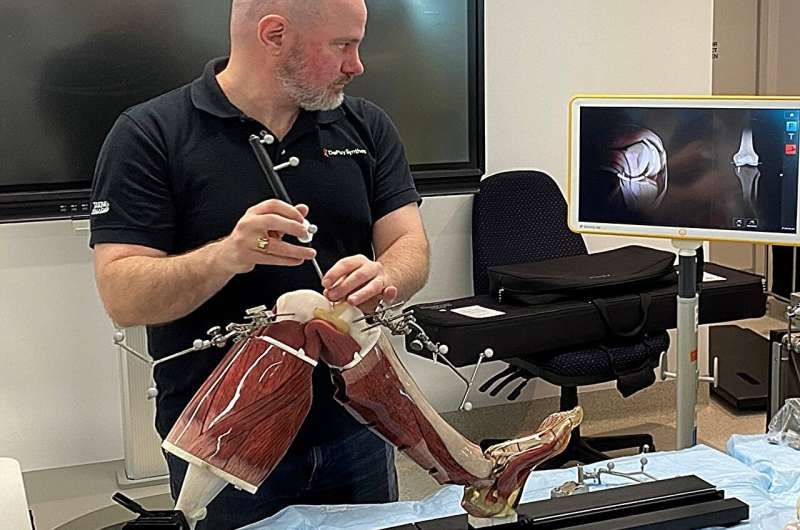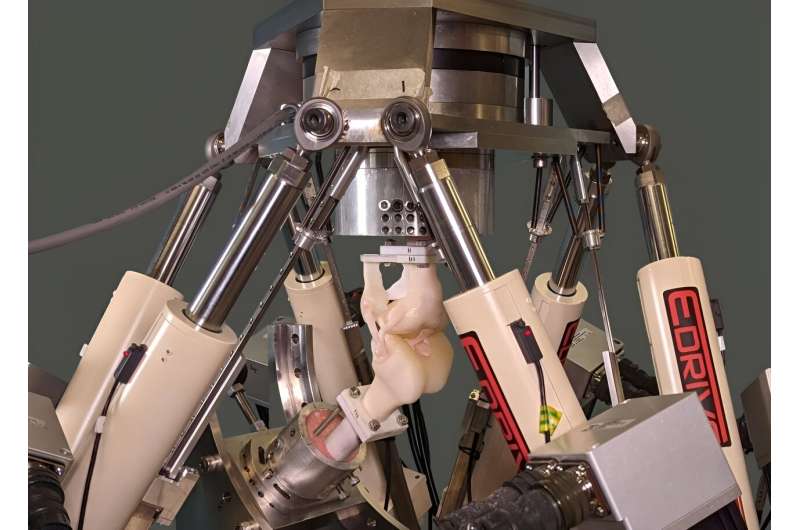This article has been reviewed according to Science X's editorial process and policies. Editors have highlighted the following attributes while ensuring the content's credibility:
fact-checked
trusted source
proofread
Next-gen knee training model heads for global markets

Successful co-design and testing of new synthetic knee models by Flinders University's Medical Device Research Institute is producing vital tools to help surgeons continue to practice and advance knee surgery methods.
While knee replacement techniques are constantly evolving, the opportunity for surgeons to practice new techniques depends on the availability of cadaveric specimens, which are in limited supply and very costly.
The new synthetic knee models—designed and manufactured by Adelaide-based company Fusetec in an industry partnership with the medical device research team at the Flinders University College of Science and Engineering—performed well in extensive mechanical testing, overcoming problems with existing models that are usually limited by a lack of biomechanical fidelity.
The next-gen models are already in use in Australia-Pacific, with pilot programs scheduled for the U.S..
Fusetec chief executive Mr. Mark Roe, a collaborator in the latest study, says innovations in surgical training models such as this artificial total knee replacement will greatly enhance the ability of higher education and upskilling of medical professionals around the world. The study, "Development and validation of a biomechanically fidelic surgical training knee model," has been published in the Journal of Orthopaedic Research.
"As well as advanced countries, it's estimated there are more than 143 million additional surgical procedures needed each year in lower- and middle-income countries to save lives and prevent disability," Mr. Roe says.
"Worldwide, at least 5 billion people do not have access to safe, affordable surgical and anesthesia care when needed—partly due to a shortage of more than 1 million specialists in 146 lower- and middle-income countries."
Professor Mark Taylor, Deputy Director of the Flinders University Medical Device Research Institute (MDRI), says the more advanced synthetic models allow surgeons to quickly gain surgical competence through repeated practice—without being limited by the availability of 'real' human knee specimens.

"Manufactured knee models may also provide more homogenous examination environments for students, ensuring fair assessments by minimizing specimen variability, even further reducing our need for cadaveric specimens," says Professor Taylor, who adds the study involved input and feedback from surgeons.
Synthetic knee training models are already in demand, but efforts to accurately reproduce the mechanics of the human knee have proved especially difficult, as passive knee mechanics are governed by a combination of hard and soft tissue interactions, with soft tissue interactions dominated by ligamentous constraints which depend on flexion.
Building on computational biomechanics tools originally developed for virtually assessed knee replacements, the MDRI team designed these ligamentous constraints needed for the Fusetec knee model to reproduce cadaveric motion before manufacturing physical models using Fusetec's Digital Anatomy Printer and testing them using the MDRI's award-winning Hexapod robot.
First author Dr. Kieran Bennett, a research fellow at Flinders University MDRI, says the collaboration aimed to design, manufacture and experimentally validate a knee surgical training model which "reproduces the flexion dependent mechanics of human knees, while maintaining anatomic accuracy."
A probabilistic finite element modeling approach was employed to design physical models to exhibit passive cadaveric mechanics. The models were tested across a wide range of flexion angles, with models showing varus-valgus and anterior-posterior mechanics within the 95% confidence interval of cadaveric measurements.
"By reproducing the mechanical function of major ligamentous structures of the knee, the models provide both anatomic and biomechanical fidelity, a limitation of previous surgical training models," says Dr. Bennett.
Future work on synthetic knee models will include developing a broader range of sizes, and with different deformities, to further expand the range of surgical procedures that can be learned and practiced before cadavers are required.
More information: Kieran J. Bennett et al, Development and validation of a biomechanically fidelic surgical training knee model, Journal of Orthopaedic Research (2024). DOI: 10.1002/jor.25873



















